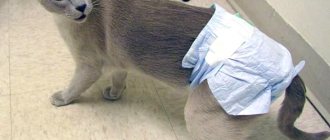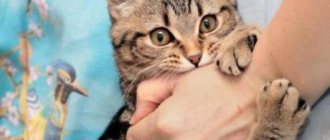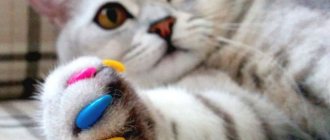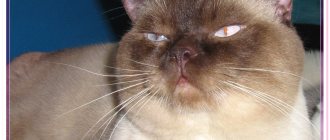Owners of one-year-old cats are faced with an unpleasant problem: the pets begin to mark their territory. Puddles in the wrong place, marks on furniture, clothes and wallpaper, a terrible smell hanging in the apartment - all this terrifies the owners. Will this nightmare really last forever? Neither punishment, nor screaming, nor attempts to eliminate the smell produce positive results. Cats mark territory, because this is inherent in them by nature. To wean a cat from marking, you can use the services of a veterinarian and castrate the animal, but there are other, less drastic methods.
The nature of the appearance of marks
It is necessary to distinguish between marks left by a sexually mature animal and the uncleanliness of a kitten. If a pet, since childhood, does not go to the litter box, but to its favorite corner, this is a real example of uncleanliness. In the event that a cat diligently went to the litter box until 8-9 months, and then suddenly began to “shit”, these are clear signs that hormones have played out in it, and the pet is marking its territory.
The chemical composition of the liquid sprayed during territory marking differs from urine. It includes hormones, pheromones, seminal fluid. This pungent odor is almost impossible to remove. The apartment begins to smell terribly. Nature arranges it in such a way that males mark their territory. These markings are clear to other animals. If there are many males in a cat pack, the most important of them puts the marks.
To prove that a domestic kitten is not the most important among the members of the new family, you will have to work hard with it. Proper parenting works wonders, so the main aspects should be considered.
Factors that cause a castrated cat to mark territory
Sometimes you have to find out how to deal with the fact that a cat marks its territory even after the castration procedure. In this situation, the problem does not arise due to the age of the pet, but due to the influence of other irritating factors. Among them the most basic can be identified:
- lack of care and attention;
- being in stressful situations;
- manifestation of internal pathologies;
- reaction to a new pet or person in the family.
Each factor has its own causes and solutions, so you need to stop yelling at the animal and figure out the problem. It will not be possible to force him to stop marking objects.
Who is the head in this house
Clarifying the relationship between a cat and a person can give positive results. The pet does not react to a scream, and if you poke its face into a puddle, it may hate it with all its heart. You need to speak cat language:
- Having caught the mustachioed Casanova in the act, you need to carefully grab him by the scruff of the neck. Cats don’t like this, they tuck their paws and tail, realizing that some kind of punishment will follow;
- Look carefully into your pet's eyes and begin to hiss threateningly. This must be done with a serious and menacing look, otherwise the animal will not react as desired;
- remembering how street cats fight, lightly (without fanaticism), hitting your own miscreant in the face. At the same time, do not look away, waiting until the pet begins to meow pitifully and looks away;
- demonstration lesson on the topic “Who is the boss in the house” was successfully completed. The cat understands that a leader has appeared on the territory and stops putting his own marks.
To consolidate the result, you need to wash off all the old marks and apply strong aromas of perfume, cologne, shoe spray, etc. over them.
This will achieve two goals: the cat will understand that the marks were placed by the leader, and on the other hand, the strong smell is unpleasant to the animal, and it will not approach the fragrant corners for a long time.
Your cat may spray urine for a number of medical problems.
Any time your pet suddenly changes its behavior, it is important to first rule out medical causes. This is also true for marking territory, as it can be caused by physical discomfort caused by stress. This means that an animal may spray urine as a result of stress. In addition, a health problem sometimes causes pain, which causes the cat to adopt a certain spraying position when urinating in order to relieve it. It is also possible that sick cats do not mark their territory, but simply pee in other places.
For example, inflammation of the urinary tract can increase the frequency and need to urinate. This may cause the cat to go outside the litter box. Due to diabetes, kidney and thyroid disease, cats may drink more and urinate more often. Of course, old age can also prevent your pet from getting to the litter box in time. This is why cat owners should always take their pets to the vet to ensure there are no health problems causing behavior changes.
Analyzes and tests will show whether the cause of this behavior is illness
A physical examination, urine test, and other diagnostic tests will show whether there is a medical reason for the behavior.
Problem: The cat has changed its habits and urine is found in the house. The urine has a different smell or there is blood in it.
How to fix it: Consult your veterinarian as soon as possible. It is important to determine what caused the change in your cat's behavior. If the problem is not related to a medical condition, your veterinarian will help guide you on next steps and may prescribe medications for anxiety. An animal behavior expert can also evaluate the problem and help you develop a treatment plan.
Inconvenient toilet
Sometimes the cat doesn't like where his litter box is. Even an animal needs privacy while defecating. If, in the animal’s opinion, the tray is located inconveniently, the pet begins to mark the corners out of spite. With this behavior he tries to attract the attention of the owner. Toilet whims can be caused by the following factors:
- Odor or excrement in the litter box. Not all pets agree to go to the dirty toilet several times. Some demonstratively begin to mark corners, drawing the owner’s attention to the dirty tray.
- Small tray. The dimensions of the box must match the size of the pet. If he experiences inconvenience when defecating in the tray, puddles begin to appear in the wrong places. These marks are a signal to the owner that the cat is dissatisfied with the existing tray.
- Some animals do not like litter or a particular type of litter, while others, on the contrary, do not want to go on a grid without litter. Each cat needs its own approach. If the marks appeared after purchasing a new filler, you need to return to the old version. If your pet does not want to go into an empty litter box, you should purchase litter in advance to avoid the hassle of an empty bag and puddles on the mat.
Diseases
Manifestations of internal pathologies have an extremely bad effect on the cat’s behavior. He begins to behave in an unusual way and marks things, even if he has never done this before. You need to immediately pay attention to this behavior in order to prevent the development of a disease that is bothering your pet.
You can stop a sick cat from marking its territory only by taking care of its health. It is necessary to take him to an experienced veterinarian for examination and identification of the cause of this condition.
The doctor will make a list of recommendations that will allow you to wean your pet from the habit that has arisen, and will prescribe treatment. As he gets better, the desire to mark furniture will gradually fade away.
Choosing a tray and a place for it
There are several types of cat litter:
- An open box with sides is suitable for any type of filler. The higher the sides, the less filler there will be on the floor. Some pets like to intensively cover their tracks; in this case, it is advisable to purchase a design with high sides curved inward. No matter how hard the cat tries, the granules will not scatter across the floor.
- A box with a grid that can be used without filling or with a small amount of absorbent granules.
- A toilet in the form of a house, into which expensive filler (silica gel) must be poured.
It is important to choose the right location for the tray.
Cats are very sensitive to the process of defecation and want to do it in a secluded place. In addition, access to the toilet must be free, that is, the door must always be open. Placing a pot in the kitchen is unhygienic. Pets don't want to go to the toilet next to their food bowl. And for people, cat litter in the kitchen is an unpleasant sight.
The bathroom is also not very comfortable. For example, one of the family members decided to take a swim, but the cat wanted to go to the toilet. He won’t wait long; he’ll go check in somewhere in the hallway or under the sofa. It is best to place the tray in the toilet. To prevent the filler stuck to the pet’s paws from spreading throughout the rooms, a rug is placed underneath.
The quality and smell of the litter can also cause hostility in the cat. There are several types of fillers, each of which has its own advantages:
- absorbent sawdust granules are the cheapest option. The disadvantages are that they need to be changed frequently; spilled granules stick to the paws and tail, so they spread throughout the rooms;
- bentonite filler - also has several varieties: small, large, medium, with herbal aroma and odorless. The price of the litter is average, the disadvantages are the pet’s paws being smeared and white marks on the floor of the toilet;
- silica gel is the most convenient, but also quite expensive type of filler. It perfectly absorbs odor, does not smear the pet’s paws and holds urine well. It is poured in a layer of 3-5 cm and changed if the granules have changed their color. This type of filler is suitable for any type of tray.
There is another option, the most optimal for everyone: to teach the cat to go to the common toilet. For this purpose, special toilet pads are available for sale. The advantages are as follows:
- no tray needed;
- no need to buy filler;
- There is no need to clean the tray.
This all saves owners money and time. But not all animals can be toilet trained. There are stubborn animals that do not want to relieve themselves in a common toilet.
Among the disadvantages of sharing a toilet, it can be noted that in a large family in the morning there is not enough time for everyone, and then there is the cat doing his business.
How to keep stray cats away from your dacha plot
The problem of how to scare cats away from a dacha plot arises for various reasons:
- A spring inspection of dacha lands revealed a settlement of stray cats, and it is almost impossible to drive away their territories, because... Over the winter they have settled into it and perceive it as their own.
- A neighbor arrived with a mustachioed pet that does not fit in his territory. Often unpleasant surprises are found throughout the dacha in the form of marks and feces.
- The arrival of a cat at the dacha aggravates the situation due to the presence of his own pet. The delimitation of territory is a real war with negative consequences for property.
We suggest you familiarize yourself with buildings on the site, distance from the fence
Any reason is compelling enough to deprive you of the comfort of a country holiday and take active action against the border violator. Getting out of this situation is often very problematic and takes a lot of time, because only humane methods are applicable to pets. In this case, there are only two ways out: completely scare away or attract the cat to a designated area.
The problem of how to keep cats away from a summer cottage can only be solved by complex measures, using several effective means at once:
- Aromatize the premises with eucalyptus, lemongrass, lavender, and coleus and wormwood are planted on the site (preferably along the perimeter). Cats do not go into areas with an unpleasant or dangerous odor in their opinion.
- Based on the principle of aromatization, special products sold in stores work, and you can find them for indoors or for open areas. They are equally effective, but not interchangeable, because “street scents” contain ingredients that imitate the urine of predators, which gives an incredible repellent effect. Such preparations are produced in liquids and powders, but they have one drawback - they erode and are easily washed off with water, so they need to be updated regularly.
- An electrical repellent device is also an effective tool that emits a sound that is inaudible to human hearing, but is perceived by cats as a threat. The devices have several negative aspects: price, you need to buy several; control and replacement of batteries; your pets will also not like this sound.
- Traditional methods: chemicals with repellent odors, planting various plants, a slingshot with light wads, your own pet. As you can see, folk methods are somewhat extreme, but no less effective, the main thing is to use them “with your head.” For example, even the owner will not like rags soaked in kerosene scattered around the area, but you can coat fence posts with a similar solution, which will look more presentable and also provide excellent anti-corrosion or anti-fungal protection.
- To get rid of stray cats from your summer cottage, you can call a special trapping service, but this will cost a lot of money, although it is very effective.
We suggest you familiarize yourself with How to knit a washcloth with crochet loops and knitting needles for beginners step by step? Beautiful do-it-yourself washcloths for baths and showers for children and adults
Outputting marks
The cat is attracted to his own marks on wallpaper, furniture and other things. To discourage him from these marks, it is necessary to eliminate the smell. You can wash the area with a disinfectant, and then place orange or lemon peels in this corner, or sprinkle ground black, red, or allspice. Vinegar does not eliminate the odor, but, on the contrary, enhances it, so it is not advisable to wash marks with water and vinegar.
The pet store recommends purchasing a repellent spray. This product is sprayed on the places that the pet has chosen for marks. There is another aerosol - to attract animals. Its purpose is to teach the cat to go to the toilet. Therefore, when purchasing, it is important not to confuse the names of the sprays.
Another trick to scare a cat away from corners: stick double-sided tape on the floor around your pet’s favorite places to visit. Sticky areas frighten the animal, and it tries not to approach them.
Food and toilet for a pet are incompatible concepts. You can use one more trick. A bowl of food should be placed in the unfortunate corner with the marks. The pet won’t even think about shitting there anymore, because food is much more important than any principles.
Conflicts caused by “struggle” for territory can also influence their behavior
A cat is a special animal that can mark territory in order to indicate to other members of the genus that this particular area belongs to it, as well as in order to minimize contact with other individuals.
What might trigger your cat's territorial instinct? Neighboring animals or multiple pets in the same home, to name a few reasons. In the first case, urine splashing may occur near doors or windows, especially if your cat often sees other animals outside and feels threatened.
For example, if a stray cat comes into your pet’s field of vision, the natural reaction to detecting an “object” will be to mark its territory, which, by the way, it can also do by sharpening its claws on furniture.
If you have a lot of cats, one of the pets may spray furniture because they are confident that they are being threatened by another animal. Keep in mind, the threat can be a glance that is invisible to the human eye, explains the veterinarian. In this situation, it would be a good idea to carefully observe the situation, separate them, and improve the sense of security in the pursued animal.
Cats often view newcomers as intruders on their territory.
Another reason for spraying may be that you have adopted another pet. Even if your cat has previously lived with other pets, you should know that cats are more picky than dogs, and they may tolerate one animal and absolutely not tolerate another. In addition, cats often view newcomers as intruders on their territory.
Problem: Other cats - outside or inside - seem to be bothering your pet and this has led to the spraying.
How to Fix It: If you have multiple indoor cats, provide multiple sitting areas and sisal or carpet scratching posts. Cats need their own space, and conflicts can often be resolved simply by giving the animals more space. Creating space can be as simple as clearing out your shelves. If the problem persists, you may need to determine which cats are not getting along. Keep them separated from each other with bedding and sleeping areas and reintroduce them slowly by adding "rewards" such as treats. If cats outside the house seem to encourage your four-legged resident's marking, then close windows, blinds and doors to prevent the indoor cat from seeing them.
Castration
The most difficult decision is to castrate your pet. If no tricks and tricks help, the pet continues to mark in the wrong places, while going to the toilet in the tray intended for this, then the problem is in hormones and sexual desire. Castration will help eliminate the natural craving for marks.
For many families, this is a painful issue, but it needs to be resolved.
Castration should not be delayed. The optimal age for surgery is 7-10 months.
If your pet is already hanging out with cats, even after neutering he will mark for some time. You need to be prepared for this.
For those who doubt whether surgery is necessary, it is recommended that you familiarize yourself with the following information:
- During castration, the gonads are removed, which helps suppress the cat's sexual desire. If this is done before the first sexual intercourse (before the age of 1 year), he will no longer mark the territory.
- After castration, the cat stops meowing mournfully, which allows not only family members, but also all neighbors to get some sleep.
- The cat stops showing aggression, does not get into fights with yard animals, which is also important, because after a fight, pets come with torn ears, black eyes, infectious skin diseases begin, lichen appears, etc.
- Many people are afraid that a neutered pet will become obese and lie lethargically on the sofa. This will happen if you don’t reconsider his diet and physical activity. There are special foods for neutered cats that prevent severe weight gain. If the pet eats only natural products, the daily amount of food is reduced by 10-20%, but the load is increased. Outdoor games, running after a ball or a candy wrapper tied on a string will not allow your pet to relax and eat off its sides.
- Pets are difficult to tolerate anesthesia. The answer to this statement is that if the pet is properly prepared for surgery, then the consequences will be minimal. The doctor will tell you how many hours before the operation the cat should not eat, and what manipulations the owner will have to perform after the cat’s operation. Animals usually recover from anesthesia within 2-3 hours, but there is no need to worry if this process takes a little longer. If the animal does not feel better 5 hours after the intervention, you must call a veterinarian.
If the owner takes a long time to decide whether to have surgery or not, time may be lost. Castration of adults does not provide a guaranteed result. The pituitary gland is also responsible for the production of sex hormones in cats, so an adult cat remembers all his love affairs and will not quickly give up on them.
Veterinarian advice
How to stop a cat from marking? Before you begin to solve this problem, you need to find out the cause. It’s one thing when an animal reacts to a change of environment in this way, and quite another if the cat has bladder problems. Therefore, to begin with, it is recommended to examine the pet.
If there are no diseases, then the cat is weaned from marking its territory using special means. They are sold in pet stores and are used to wean the animal from marking. The solution is used to treat favorite areas where the pet leaves its “calling cards”. Such funds are quite expensive.
You can also treat corners with home remedies. Chlorine, nail polish remover, and bleach are excellent odor control agents. Cats do not like the aromas emitted by such products, and it is unlikely that a hooligan will want to recover in a place where the same bleach has left its mark and smell.











